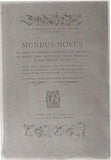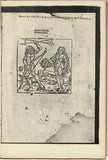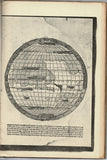Mundus Novus. Ein Bericht Amerigo Vespucci's an Lorenzo de Medici über sein reise Nach Brasilien in den Jahren 1501/02
Author: Vespucci, Amerigo (1454-1512)
Year: 1903
Publisher: Heitz & Mundel
Place: Strassburg
Description:
23+[10 facsimile]+[2 ad] pages with map and table. Folio (14" x 9 1/2") bound in original wrappers. Text by Kurt Trubenbach. Facsimile work by Emil Sarnow. First edition thus.
In 1508 the position of chief of navigation of Spain (piloto mayor de Indias) was created for Vespucci, with the responsibility of planning navigation for voyages to the Indies. Vespucci's first encounter with native Americans in Honduras, 1497. Two letters attributed to Vespucci were published during his lifetime. Mundus Novus (New World) was a Latin translation of a lost Italian letter sent from Lisbon to Lorenzo di Pierfrancesco de' Medici. It describes a voyage to South America in 1501–1502. Mundus Novus was published in late 1502 or early 1503 and soon reprinted and distributed in numerous European countries. Lettera di Amerigo Vespucci delle isole nuovamente trovate in quattro suoi viaggi (Letter of Amerigo Vespucci concerning the isles newly discovered on his four voyages), known as Lettera al Soderini or just Lettera, was a letter in Italian addressed to Piero Soderini. Printed in 1504 or 1505, it claimed to be an account of four voyages to the Americas made by Vespucci between 1497 and 1504. A Latin translation was published by the German Martin Waldseemüller in 1507 in Cosmographiae Introductio, a book on cosmography and geography, as Quattuor Americi Vespuccij navigationes (Four Voyages of Amerigo Vespucci). In the 18th century three unpublished familiar letters from Vespucci to Lorenzo de' Medici were rediscovered. One describes a voyage made in 1499–1500 which corresponds with the second of the "four voyages". Another was written from Cape Verde in 1501 in the early part of the third of the four voyages, before crossing the Atlantic. The third letter was sent from Lisbon after the completion of that voyage. Some have suggested that Vespucci, in the two letters published in his lifetime, was exaggerating his role and constructed deliberate fabrications. However, many scholars now believe that the two letters were not written by him but were fabrications by others based in part on genuine letters by Vespucci. It was the publication and widespread circulation of the letters that might have led Martin Waldseemüller to name the new continent America on his world map of 1507 in Lorraine. Vespucci used a Latinised form of his name, Americus Vespucius, in his Latin writings, which Waldseemüller used as a base for the new name, taking the feminine form America, according to the prevalent view. The book accompanying the map stated: "I do not see what right any one would have to object to calling this part, after Americus who discovered it and who is a man of intelligence, Amerige, that is, the Land of Americus, or America: since both Europa and Asia got their names from women". It is possible that Vespucci was not aware that Waldseemüller had named the continent after him. On March 22, 1508, King Ferdinand made Vespucci chief navigator of Spain at a huge salary and commissioned him to found a school of navigation, in order to standardize and modernize navigation techniques used by Iberian sea captains then exploring the world. Vespucci even developed a rudimentary, but fairly accurate method of determining longitude (which only more accurate chronometers would later improve upon). The two disputed letters claim that Vespucci made four voyages to America, while at most two can be verified from other sources. At the moment there is a dispute between historians on when Vespucci visited mainland the first time. Some historians like German Arciniegas and Gabriel Camargo Perez think that his first voyage was done in June 1497 with the Spanish Pilot Juan de la Cosa. Vespucci's real historical importance may well rest more in his letters, whether he wrote them all or not, than in his discoveries. From these letters, the European public learned about the newly discovered continents of the Americas for the first time; its existence became generally known throughout Europe within a few years of the letters' publication.
Condition:
Edge war to wrappers with some closed tears, spine heal chipped with tear to hinge else a very good copy.











